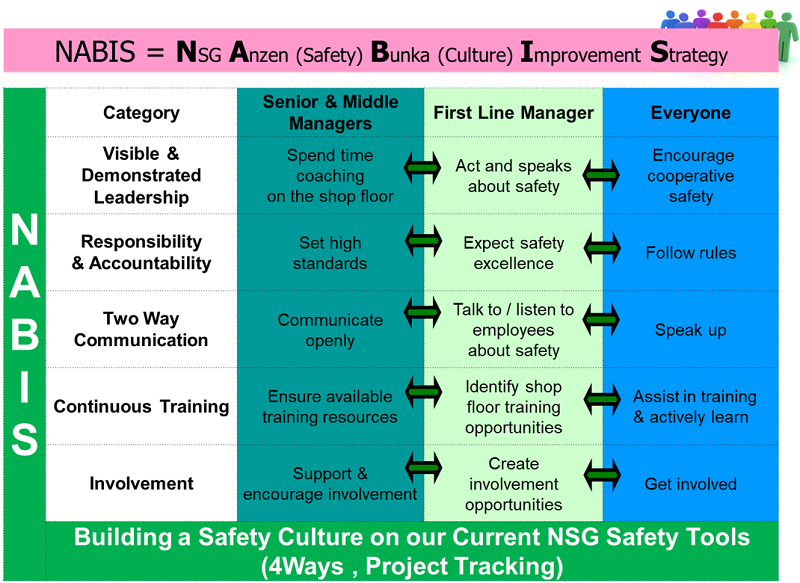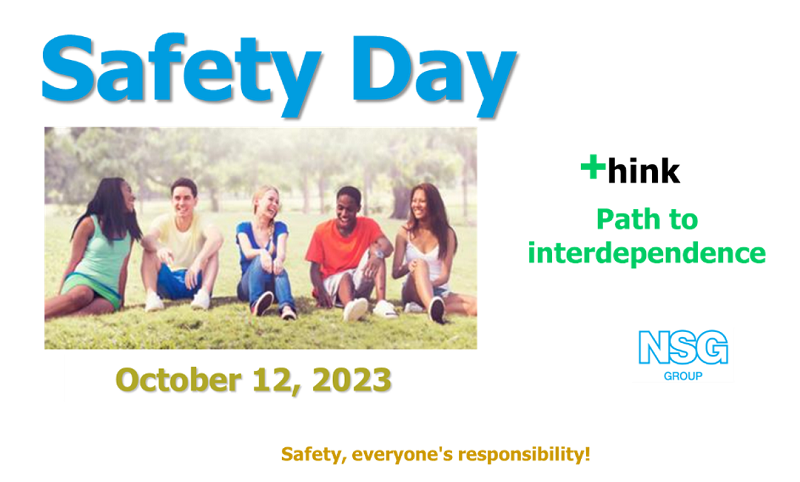Health and Safety
Our safety programs emphasize the importance of our vision and values, that people are our most important asset and the safety of our employees and the communities in which we operate is a core part of our ethical business philosophy.
Please refer to the "NSG Group Health and Safety Policy".
Safety organization and strategy
The NSG Group Sustainability Director reports to the President and CEO Munehiro Hosonuma.
Monthly safety updates are provided to the Operational Performance Review meetings while more in-depth management reviews are completed every six months with the senior operations team comprising the heads of the four SBUs and the heads of the Group functions.
All injuries at work are regarded as avoidable. We require full reporting of all incidents, no matter how minor, and appropriate investigation to ensure we learn from all such events. The Group has a focused site approach that provides additional support and more regular reviews for sites that have more than a defined number of significant injuries.
Improving our root cause analysis is a fundamental part of the group’s improvement strategy, it is only by identification of the underlying causes of accidents and incidents that the group operations will improve in the longer term. In order to further develop the ability of the group to enhance the learning opportunities from accident and incident the group has implemented a new reporting and investigation tool from EcoOnline in NSG we call this system AVA. The system has been implemented globally in a phased approach.
The next stage for AVA is to further support the health and safety programs with the introduction of a behavior measure and an auditing system.
Safety performance FY24
Following the two fatal accidents that occurred in FY22, we started to strengthen our vehicle and pedestrian safety programs, and improvements are being made throughout the Group. In FY23 and FY24, we created a list to analyze the gap between the ideal situation and the current situation, and based on this, we implemented physical separation of vehicles and pedestrians. In addition, the introduction of mechanical collision avoidance systems such as the TAG system and camera system has begun for some vehicles, and we will continue to accelerate their introduction in the future.
The significant injury rate records injuries requiring specialized medical treatment or the injuries where the same work cannot be continued and there is a loss of work, expressed as a rate per 200,000 hours worked. The Significant Injury Rate for the year to March 31 2024 remained at 0.32, same with FY23. We continue to focus on reducing insecure behavior by strengthening leadership and communication, particularly through the Gemba Walk*.
*Gemba Walk; Activities of safety patrol by managers in order to identify and improve safety issues in workplace through communications between managers and operators.
NSG Group’s initiatives for safety
NSG Group is continuing to drive proactive safety through a measure called NABIS (NSG Anzen Bunka Improvement Strategy) this process has three main areas reflecting our focus points. NABIS consists of five components: Leadership, Responsibility and Accountability, Communication, Training, and Involvement.

-
Leadership
Leaders at all levels of the business are being asked to make their leadership visible and actionable by, for example, using processes such as GEMBA walks to spend more time talking with field leaders and employees about various improvement opportunities.
To further improve the GEMBA-walk process the group is starting to measure the numbers of GEMBA walks completed and reviewing information derived from the process.
We continue to ensure all our leaders assess themselves against our 10 key leadership behaviors, asking them to lead by example and to review their teams against a set of principles, such as never walking past an unsafe act without talking to the individual.
-
Responsibility and accountability
Leadership teams must ensure that people follow the procedures and safety rules for the tasks we ask them to complete. This area continues to ask leaders to consistently review the ability of their colleagues to competently complete the tasks. This also forms part of the GEMBA process in that leaders observe how individuals are working and identify learning opportunities. We also promote the identification of risks and quantitative assessment of risks in our four lines of business, including new projects.
-
Communication
Improving the way in which we communicate safety through regular opportunities for two-way briefings and more formal safety meetings with employees and their representatives is an important way of providing clear information on both reactive and proactive safety initiatives. Leadership teams are required to ensure this communication process is effective.
In FY23 the NSG Group will introduce a safety culture survey to be completed at its larger manufacturing facilities in Architectural, Automotive and Creative Technology. This survey will provide leadership teams with feedback on the current level of safety culture in their plants; in addition, it will also allow employees to provide anonymous comments and suggestions to help plants improve.
In certain regions and countries the group has formal communication and discussion with employees unions, for example, in Europe the business hold a forum with unions from the Germany, Spain, Italy, Finland the UK etc. this is held on a 6 monthly basis.
-
Training
Ensuring our employees have the tools and ability to deliver our commitments in a safe and ethical manner requires a continual review and update on training needs and competences. Leaders are required through NABIS to ensure that, from a safety point of view, people have the correct knowledge to complete this task.
-
Involvement
Asking people to become proactively involved in safety in our plants is part of the leader's responsibility and in NABIS we ask our leadership teams to look for opportunities to involve teams and individuals in safety projects, with the implementation of suggestion schemes and participation in Kaizen processes across many of our larger manufacturing plant being a part of this process.
In addition, as an opportunity of Involvement for all employees, NSG Group Safety Day is held every October, a day for all Group employees to think about safety. Last year, related events were held on October 12 at sites around the world.
Last year's common theme was “The Path to Mutual Enlightenment”. The goal is to build a culture in which each employee considers not only their own actions, but also the actions of their colleagues, and in which the entire team works together to raise the level of safety.

Finally, NABIS requires our leadership teams to manage our high-risk activities.
We are committed to our high-risk reduction program and the safety tools we have in place. We continue to focus on the following areas:
- Working where there is a risk of falling
- Vehicle and pedestrian safety
- Machinery safety: guarding, FASS* and complete isolation
- Contractor control, including permits
- Materials handling: moving glass, load security, grabs, trolleys and pallets
- Driving in connection with work
*FASS (Frequent Access Safety System) is a system that partially stops equipment by interlocking, etc.
The Groups commitment to NABIS for larger sites has been reinforced around the globe with a verification process. This ensures Health and Safety professionals within the group review the self assessment scores submitted by the larger operational plants. This process forms part of plant leadership team’s performance reviews.
Over the past three years, the NSG Group has been promoting introduction of the NABIS process in small plant and office to achieve its goal of having all employees involved in the NABIS process.
Moving safety to the next level
The safety strategy within the group remains, it will continue to focus on improving the effectiveness of our safety tools and programs. The goal is to achieve a high level of safety culture by continuing to focus on NABIS.
At the same time, the following priority measures will promote the reduction of potential high risks on site:
- Further improvements will be made with regard to vehicle and pedestrian safety, building on the risk identification carried out to date. Particular focus will be given to the increased implementation of TAG and camera systems.
- Focusing on Very High Potential Severity (VHPS) events from the Significant Injury (SI) that have occurred, the system completes risk reduction measures that are common to all sites in the Group.
- CCTV cameras and AI will assist in the identification of risks, unsafe conditions and behaviors on site, and reduce risk reduction activities and unsafe behaviors.
Significant Injury (SI), Lost Time Injury (LTI) and Facilities